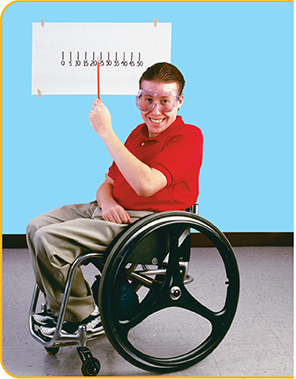Have your partner use a meter stick to move the pencil 0.5 m toward the marks. Without moving your head, cover your left eye and look at the pencil with your right eye. Your partner should record the number of the mark the pencil lines up with.
Without moving your head, cover your right eye and look at the pencil with your left eye. Your partner should record the number of the mark the pencil lines up with.
To determine the parallax, subtract the righteye measurement from the left-eye measurement. Record the parallax in the appropriate place in your data table.
Repeat Steps 9 through 11 until the parallax is less than 1 cm.
Construct a graph of the distance to the star (pencil) against the parallax you calculated. Plot the parallax on the horizontal axis and the distance on the vertical axis.

Analyze and Conclude
Using Graphs What does your graph show is the relationship between the distance to the pencil and the pencil's parallax?
Analyzing Data Was your prediction in Step 8 correct? Explain your answer.
Drawing Conclusions Assume that a parallax of less than 1 cm is too small to be measured. What is the maximum distance at which the pencil would still have a parallax you can measure?
Applying Concepts Parallax can only be used to measure the distances to nearby stars. Why can't this method be used to find the distances to far-away stars?
Inferring Astronomers usually make two measurements of the position of a star six months apart, when Earth is at opposite sides of its orbit. How is this useful in determining the star's parallax?
Go Further
Use the library or the Internet to research how distances to stars are actually measured using parallax. What kinds of telescopes and other technology are used? What is the greatest distance to a star that has been measured using parallax? How do astronomers determine the distances of stars that are too far away from Earth to have a measurable parallax?




